Synergistic Effect of Adjuvants on Clomazone
Tao Bo ,He Dong-xue ,Li Song-yu ,Li Qiu-cheng ,Zhao Xu ,Zhang Qi ,Guo Jing,and Liu Xiao-jie
1 College of Agriculture,Northeast Agricultural University,Harbin 150030,China
2 Heilongjiang Green Food Science Research Institute,Harbin 150028,China
Abstract:Adjuvants have the potential to improve the weed control efficacy of herbicides.The synergistic effects of different types of adjuvants on clomazone and the safety of soybean were studied systematically by bioassay,instrumental analysis and field trial methods.The results showed that the five different types of adjuvants all differentially enhanced the herbicidal effects of clomazone;the compound adjuvant had the best synergistic effect on clomazone,and the plant control effect and the fresh weight control effect of clomazone on weeds could be increased by 24.2% and 24.11%,respectively.Through the study of the physical properties of the solution,the results showed that the adjuvants reduced the surface tension by 15.66%-33.23%,increased the expansion diameter by 11.56%-63.19%,reduced the contact angle by 8.40%-71.49%,and shortened the drying time by 3.1%-37.75%.Among the adjuvant options,the compound adjuvant exhibited the best effect,reducing the surface tension by 26.03%-33.23%,increasing the expansion diameter by 39.81%-63.19%,reducing the contact angle by 33.22%-71.49%,and shortening the drying time by 28.85%-37.75%.All the adjuvants had no significant effect on soybean plant height and yield and were safe for soybean.The reasonable development and application of adjuvants in China's agricultural practices had good practical basis and significant value.
Key words:clomazone,soybean,physical property,control effect,safety
Introduction
Soybean is an important grain and oil crop in China and the main source of plant protein for human needs(Zhanget al.,2018;Wuet al.,2021).Damage due to weeds is a major problem in soybean production and is controlled by herbicides,mechanical tillage and hand weeding (Li,2014).Chemical weed control is the most effective weeding method.
Clomazone is an organic heterocyclic herbicide with long duration,wide control range and high herbicidal activity (Wanget al.,2003;Baiet al.,2009).It can be used as a preemergence soil treatment (Zhanget al.,2021) and also as a postemergence stem and leaf treatment (Fu,2015;Li,2020),effectively controlling annual gramineous weeds and broadleaf weeds (Zhanget al.,2016),and is a commonly applied herbicide in soybean fields throughout China.However,clomazone has a longer residual period,and its activity is retained for 24 months in soil and at least 130 days in water(Zanellaet al.,2002;Zanellaet al.,2008;Liet al.,2011).With increasing rates of clomazone application,the injury to wheat,cabbage,sugar beet and other sensitive crops has occurred,leading to serious environmental pollution (Mironet al.,2009).At present,it is urgent that the dosage of clomazone per unit area in China is reduced for reducing its residues in soil and water,and the occurrence of subsequent crop injury,and improving the safety of clomazone to crops and the environment.
Adjuvants can increase herbicide activity,decrease herbicide doses,and improve crop safety (Liet al.,2020;Tianet al.,2020).Adjuvants are mainly optimized for the physical properties of herbicide droplets to increase the control effect (Taoet al.,2021).Surfactants are commonly used to reduce the surface tension of droplets,improve the infiltration and distribution of droplets on target organisms,increase the contact area,and increase the amount of drug absorption (Ralph,1999;Zuoet al.,2012).Oil adjuvants can dissolve the waxy layer of the target crop leaves and effectively improve the penetrating ability of the drug,significantly increase droplet adhesion,reduce droplet splashing and rolling,and enhance the erosion ability of rain (Pannacciet al.,2010).Organosilicon adjuvants can improve droplet diameter within a short time,expand the range of target crops,and increase the absorption rate of target crops (Hess and Falk,1990;Stevens,2010;Da Mmeet al.,2016).Carbohydrate adjuvants can enhance the retention,adsorption,dispersion and penetration of pesticides,thereby improving the application effect of pesticides (Taoet al.,2016).The use of adjuvants is affected by various properties,affecting the safety and efficacy of herbicides,and has an important impact on the safety and quality of crops.
The aims of this research were to solve the problems of crop injury and serious soil residue in the use of clomazone in soybean fields.The synergistic effects of different types and physical properties of adjuvants on clomazone were studied,and the safety of soybean in regard to clomazone was evaluated.By adding adjuvants,the amount of clomazone was reduced,and the residual amount of clomazone in the soil and crop damage were reduced,and the safety of clomazone was improved,and the input cost of clomazone in soybean fields was reduced.The results of this study could provide the theoretical guidance for the selection of clomazone adjuvants in the field.
Materials and Methods
Test materials
Forty-eight percent clomazone EC was provided by Liaoning Zhuangmiao Biochemical Technology Co.,Ltd (Liaoning,China).Compound adjuvants (the main components are carbohydrate and nitrogen salts without herbicides) were provided by Harbin Yinhe Biotechnology Co.,Ltd (Harbin,China).Nonionic surfactant adjuvant was provided by Harbin Yinhe Biotechnology Co.,Ltd (Harbin,China).Oil adjuvant was provided by Harbin Yinhe Biotechnology Co.,Ltd (Harbin,China).The organosilicon adjuvant was provided by Heilongjiang Jindi Biological Technology Co.,Ltd (Harbin,China).Carbohydrate adjuvant was provided by the Pesticide Laboratory of Northeast Agricultural University (Harbin,China).Abutilon was provided by Xiangyang Farm,Harbin,China.
Greenhouse trials
The experiment was carried out in the greenhouse of the Horticultural Experiment Station,Northeast Agricultural University(126.7°E,45.7°N),Heilongjiang Province,in 2019.The soil at the experimental site was black soil with 2.9% organic matter and pH of 6.9.The weedAbutilon(Abutilon theophrastiMedic.) seeds were collected from Xiangyang Farm.Weed seeds of uniform size and fullness were planted in pots (diameter 16 cm,high 19 cm).After emergence,every pot was maintained with seven seedlings of uniform and healthy growth.Weed seedlings were grown in the greenhouse under an average day/night temperature of 27℃/18.5℃under natural daylight conditions with watering every three days.Clomazone was sprayed at the 4-5 leaf stage using a knapsack sprayer delivering 250 L · hm-2(20 L · 667 m-2) with Teejet 80015 flat fan nozzles.Treatments consisted of clomazone(Chusancai,commercial product,Zhuangmiao Biochemical Technology) doses at 360 and 450 ga.i.· hm-2(the typical use rate of 360 ga.i.· hm-2) alone and clomazone dose at 360 ga.i.· hm-2mixed with 0.3%(V/V) compound adjuvant,0.5% (V/V) organosilicon adjuvant,0.5% (V/V) oil adjuvant,0.7% (V/V)nonionic surfactant and 0.7% (V/V) carbohydrate adjuvant.The weed control effect was recorded for 14 days,and the fresh weight control effect was recorded for 28 days after treatment (DAT).The experiment was repeated under similar conditions.Experiments were designed in a randomized complete block with three replications.
Effects of adjuvants on physical properties of clomazone
A 500 mL clomazone solution was prepared with 48% clomazone EC at 360 ga.i.· hm-2with a sprayer delivering 250 L · hm-2.Compound adjuvant,organosilicon adjuvant,oil adjuvant,nonionic surfactant and carbohydrate adjuvant were added to the above solution.Five concentration gradients of adjuvants were set,and the contents (V/V) were 0.1%,0.3%,0.5%,0.7% and 1%,respectively.According to the GB/T 38722-2020 ring membrane method (Gimeneset al.,2013),the surface tension of the above drug solution was measured using a tensiometer with an SCI100C surface tension system (Shanghai Zhongchen Digital Technology Equipment Co.,Ltd.).
Five microliters of the above solution were dropped onto a smooth and dry slide surface using a micro sampler.The expanded diameter and contact angle of the solution were measured with a JC2000D3 contact angle measuring instrument (Shanghai Zhongchen Digital Technology Equipment Co.,Ltd.).
Five microliters of the above solution were dropped on a smooth and dry slide surface using a pipetting gun,and the drying time of the droplet was recorded with a second meter under the same environmental conditions.
The experiment was repeated three times.
Field test
Field experiments were established at Xiangyang Farm to test the weed control in soybean fields.The test soil was black soil at pH 6.9 with 3.69% organic matter content.Soybeans were planted by mechanization in rows spaced 65 cm apart at a rate of one seed per 10 cm of row.The broadleaf grass types in the field mainly includedAbutilon(Abutilon theophrastiMedicus),nightshade (Solanum nigrumL.) andXanthium(Xanthium strumarium).The gramineae weed types in the field mainly included barnyard grass (Echinochloa crusgalli(L.) P.Beauv.),common crabgrass(Digitaria sanguinalis(L.) Scop.) andSetaria grass(Setaria viridis(L.) Beauv.).Clomazone was sprayed during the 3-5 leaf stage of gramineae weed and the 4-5 leaf stage of broadleaf grass using a knapsack sprayer delivering 250 L·hm-2(20 L · 667 m-2) with Teejet 80015 flat fan nozzles.Treatments consisted of clomazone doses at 360 ga.i.·hm-2alone and mixeduse with the most suitable dosage adjuvant 0.5% (V/V)selected based on physical properties;clomazone doses at 480 ga.i.· hm-2alone as a control.Each pot was 50 m2.Experiments were designed in a randomized complete block with three replications.The weed control effect was investigated after 14 days,and the fresh weight control effect was investigated after 28 days.The experiment was repeated three times.
Safety evaluation of adjuvants mixed with clomazone
The experimental treatments and methods were the same as the field trials.There were additional treatments of 0.5% (V/V) adjuvants alone under conditions of hand weeding and no herbicide/adjuvant spraying and hand weeding treatment.The experiment was repeated three times.The plant height of soybean was recorded on the 7th,14th and 28th days after treatment application.After the soybean crop was mature,each plot was randomly sampled at three points,and the number of pods,grains,100-grain weight and yield were recorded.
Data analysis
All the data were subjected to analysis of variance(Duncan's test) using DPS statistical software.
Results
Greenhouse trials
The results in Table 1 suggested that clomazone applied at a rate of 360 ga.i.· hm-2mixed with adjuvant exhibited better control of abutilon.By adding the compound adjuvant,organosilicon adjuvant,oil adjuvant,nonionic surfactant and carbohydrate to the spray solution,weed plant control was increased by 15.09%-21.5%,and the fresh weight control effect was increased to 16.94%-23.05%.These results indicated that different types of adjuvants had different degrees of efficacy enhancement on clomazone.The compound adjuvant mixed with herbicides showed the strongest synergistic ability,with significant differences from other treatments,and the plant efficacy and fresh weight efficacy increased by 21.5% and 23.05%,respectively.Oil adjuvant and organosilicon adjuvant were the second most effective,and the fresh weight control efficiency increased by 19.05% and 19.44%,respectively;nonionic surfactant and carbohydrate adjuvant were generally effective,with plant control efficiency increasing by 15.09% and 12.28%,and the fresh weight control efficiency increased by 16.94%and 13.74%.

Table 1 Effects of different adjuvants on efficacy of clomazone
Effects of different adjuvants on surface tension of clomazone solution
By adding compound adjuvant,organosilicon adjuvant,oil adjuvant,nonionic surfactant and carbohydrate to the clomazone,the surface tension of the herbicide solution was decreased to different degrees and decreased with adjuvant concentration increasing.When the adjuvant density was greater than 0.5% (V/V),the surface tension of the herbicide solution was basically stable.When the adjuvant density was 0.5% (V/V),the compound adjuvant exhibited the strongest ability of reducing the surface tension of the solution,which was significantly different from other treatments.The surface tension after mixing with the compound adjuvant was reduced by 32.02%.The ability of organosilicon adjuvant and nonionic surfactant were the second most effective,which were decreased by 29.55% and 27.15%,respectively.Oil adjuvant and carbohydrate adjuvant had general ability of reducing surface tension,and there was no significant difference between the two treatments,which were decreased by 24.14% and 22.41% (Fig.1).
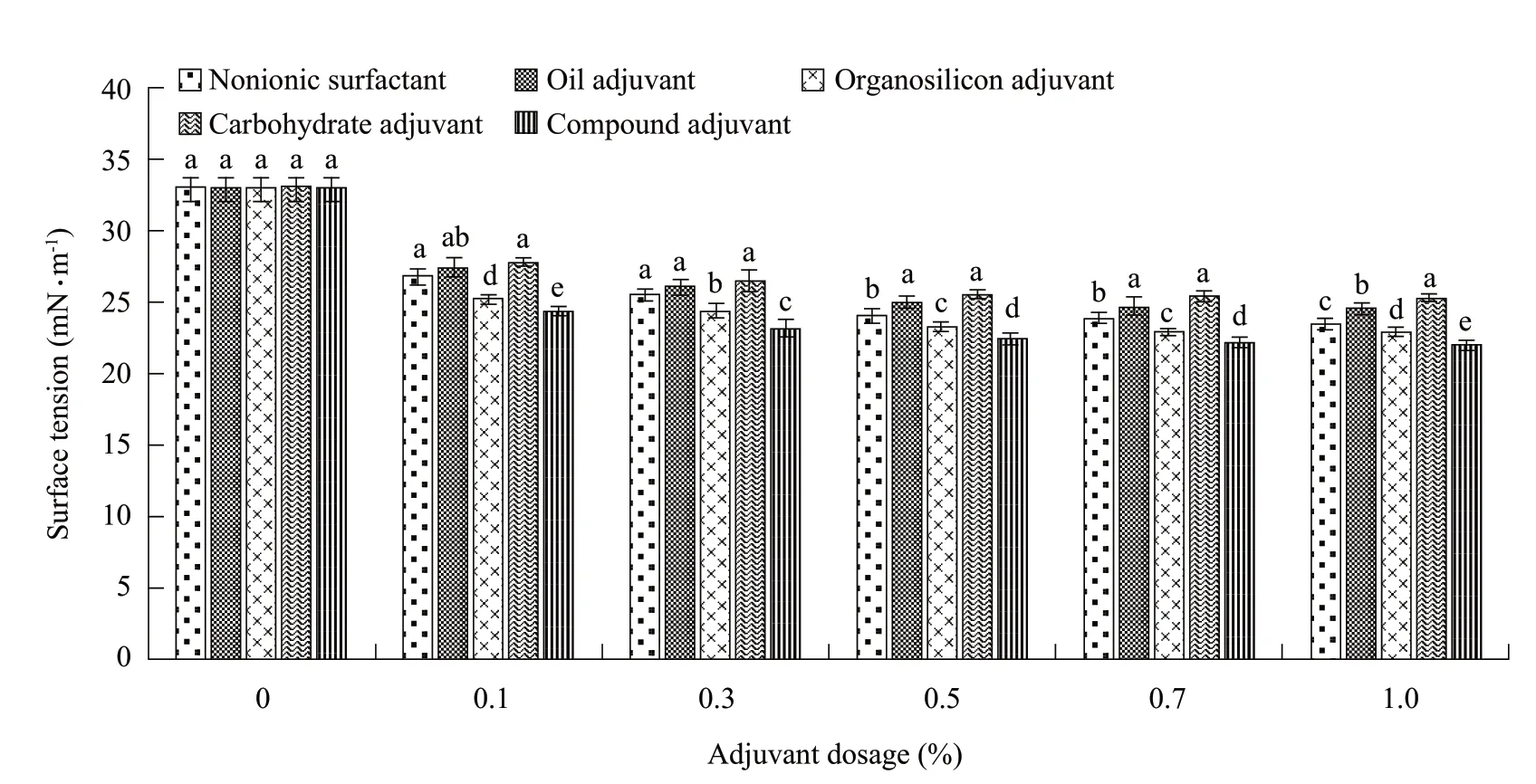
Fig.1 Effects of different adjuvants on surface tension of clomazone solution
Effects of different adjuvants on expanded diameter of clomazone solution
By adding compound adjuvant,organosilicon adjuvant,oil adjuvant,nonionic surfactant and carbohydrate to clomazone,the expanded diameter of the herbicide solution increased significantly and increased with mixed adjuvant dose increasing.When the adjuvant density was greater than 0.5% (V/V),the expanded diameter of the herbicide solution was basically stable.When the adjuvant concentration was 0.5% (V/V),the effect of each adjuvant on herbicide solution expansion diameter was significantly different;the compound adjuvant had the best effect on solution expansion diameter with the increase of 58.14%;organosilicon adjuvant,nonionic surfactant,oil adjuvant and carbohydrate adjuvant increased the expansion diameter compared with the control group by 53.75%,43.95%,40.88% and 36.64%,respectively.Adjuvants could increase the expansion diameter of the herbicide solution,which was conducive to the extended distribution of droplets on weed leaves and was good for the absorption and conduction (Fig.2).
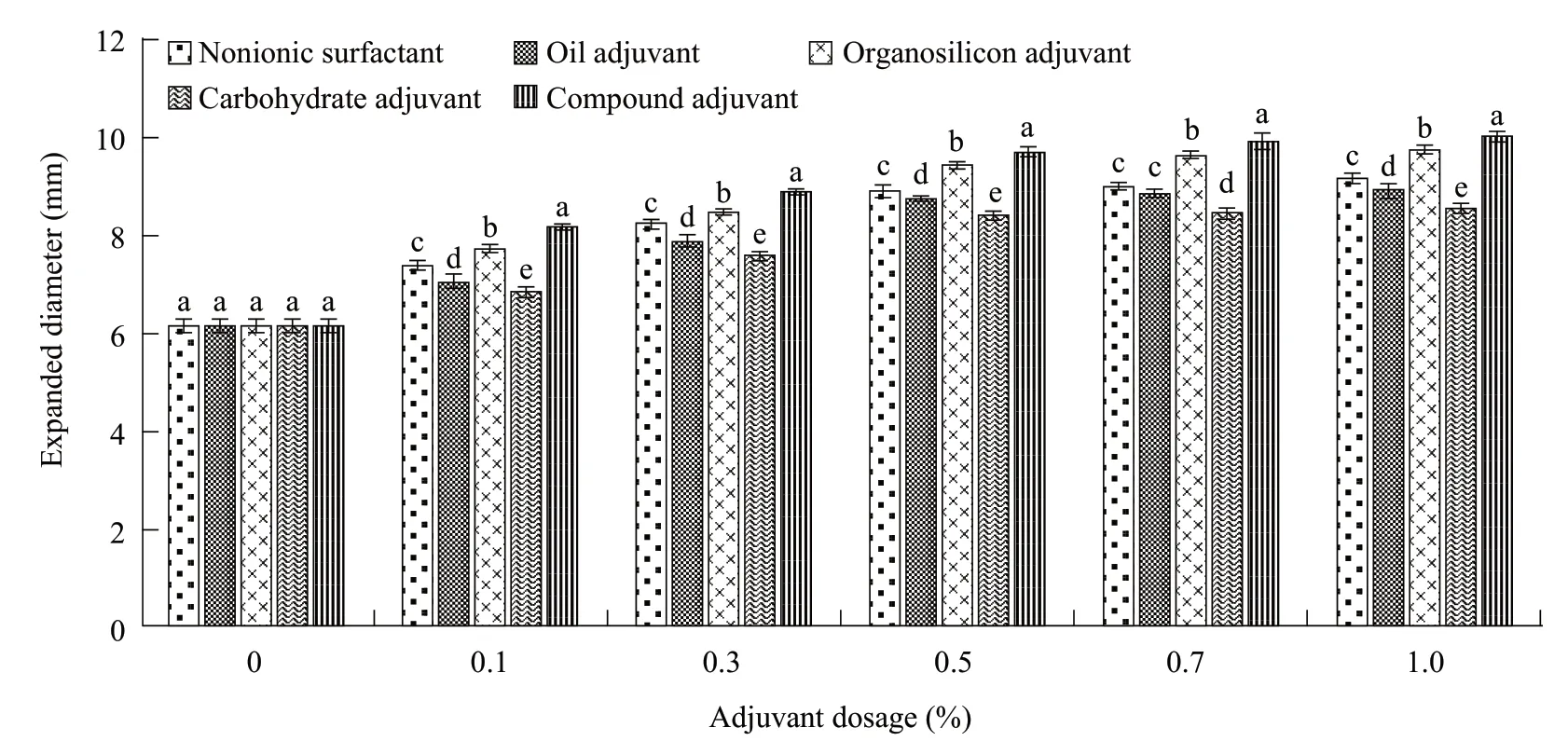
Fig.2 Effects of different adjuvants on expanded diameter of clomazone solution
Effects of different adjuvants on contact angle of clomazone solution
The results in Fig.3 suggested that clomazone applied at a rate of 360 ga.i.·hm-2mixed with adjuvants significantly decreased the contact angle.With the increase in the concentration of the mixed adjuvants,the contact angle of the herbicide solution decreased continuously.When the adjuvant addition amount was greater than 0.5%(V/V),compared with the control treatment,the compound adjuvant had the strongest ability of reducing the contact angle of the herbicide solution with a reduction of 69.79%,which was significantly different from other additives;the ability for the organosilicon adjuvant,nonionic surfactant and oil adjuvant of reducing the contact angle was weaker than that of the compound adjuvant,with the reductions of 66.20%,59.72% and 50.39%,respectively;the ability for the carbohydrate adjuvant of reducing the contact angle of the herbicide solution was general at 39.1%.

Fig.3 Effects of different adjuvants on contact angle of clomazone solution
Effects of different adjuvants on drying time of clomazone solution
The results in Fig.4 suggested that clomazone mixed with compound adjuvant,organosilicon adjuvant,oil adjuvant,nonionic surfactant and carbohydrate greatly extended the drying time of the herbicide solution.With the increase in the concentration of the mixed adjuvants,the drying rate of the herbicide solution gradually increased.When the amount of adjuvant was 0.1%-1% (V/V),the drying time of the five adjuvants was accelerated by 3.10%-37.75%.When the adjuvant amount was greater than 0.5% (V/V),the drying time of the herbicide solution fluctuated minimally and was almost stable.When the additive amount was 0.5%(V/V),the effects of compound adjuvant,organosilicon adjuvant,nonionic surfactant,oil adjuvant and carbohydrate adjuvant for reducing the drying time of solution were significantly different,which were shortened by 35.93%,33.96%,31.61%,29.27%and 24.58%,respectively.Among them,compound adjuvant had the strongest ability of accelerating the drying time.
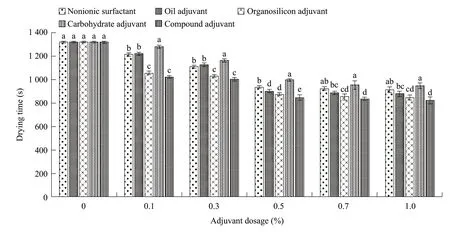
Fig.4 Effects of different adjuvants on drying time of clomazone solution
Field test
The effects of different adjuvants on the herbicidal activity of clomazone were further tested.The results in Table 2 suggested that all the five adjuvants could significantly increase the weed control effects of clomazone.When clomazone was applied at a rate of 360 ga.i.· hm-2mixed with compound adjuvant,organosilicon adjuvant,oil adjuvant,nonionic surfactant and carbohydrate adjuvant,the plant control effect and fresh weight control effects on the weeds were significantly increased compared with clomazone alone applied at a rate of 450 ga.i.· hm-2.The synergistic effect of compound adjuvant was the best,and the control effects on the weeds and fresh weight were increased by 24.2% and 24.11%,respectively;organosilicon adjuvant and oil adjuvant had the second highest potentiation effect,but it had obvious synergistic effect compared with the control;the synergistic effect of carbohydrate adjuvants was poor,which was increased only about 12%.Therefore,adjuvants could improve the weeding activity and reduce the needed dosage.Different types of additives resulted in the differences of efficiency.

Table 2 Effects of different adjuvants on efficacy of clomazone
Safety evaluation of adjuvants mixed with clomazone
As shown in Table 3,there was no significant difference in soybean plant height between hand weeding and the application of clomazone alone,indicating that clomazone was safe for soybeans at 360 and 450 ga.i.· hm-2.There was no significant difference in soybean growth between hand weeding and mixtures of the five adjuvants with clomazone at 360 ga.i.· hm-2.Differences in soybean plant height between the treatments with adjuvants alone and the hand weeding treatment were not significant,but did differ significantly from the treatment without added herbicides/adjuvants.Compound adjuvant,organosilicon adjuvant,oil adjuvant,nonionic surfactant and carbohydrate adjuvant had no adverse effects on the growth of soybean and thus were considered safe for soybean.
As shown in Table 4,there was no significant difference in soybean yield among treatments with herbicides mixed with adjuvants,treatments with adjuvants alone,treatments with herbicides alone and manual weeding treatments,indicating that adjuvants had no effects on the safe production of soybeans.Therefore,compound adjuvant,organosilicon adjuvant,oil adjuvant,nonionic surfactant and carbohydrate adjuvant mixed with clomazone had no effects on the growth and maturity of soybeans in field production and had a high level of safety for soybeans.
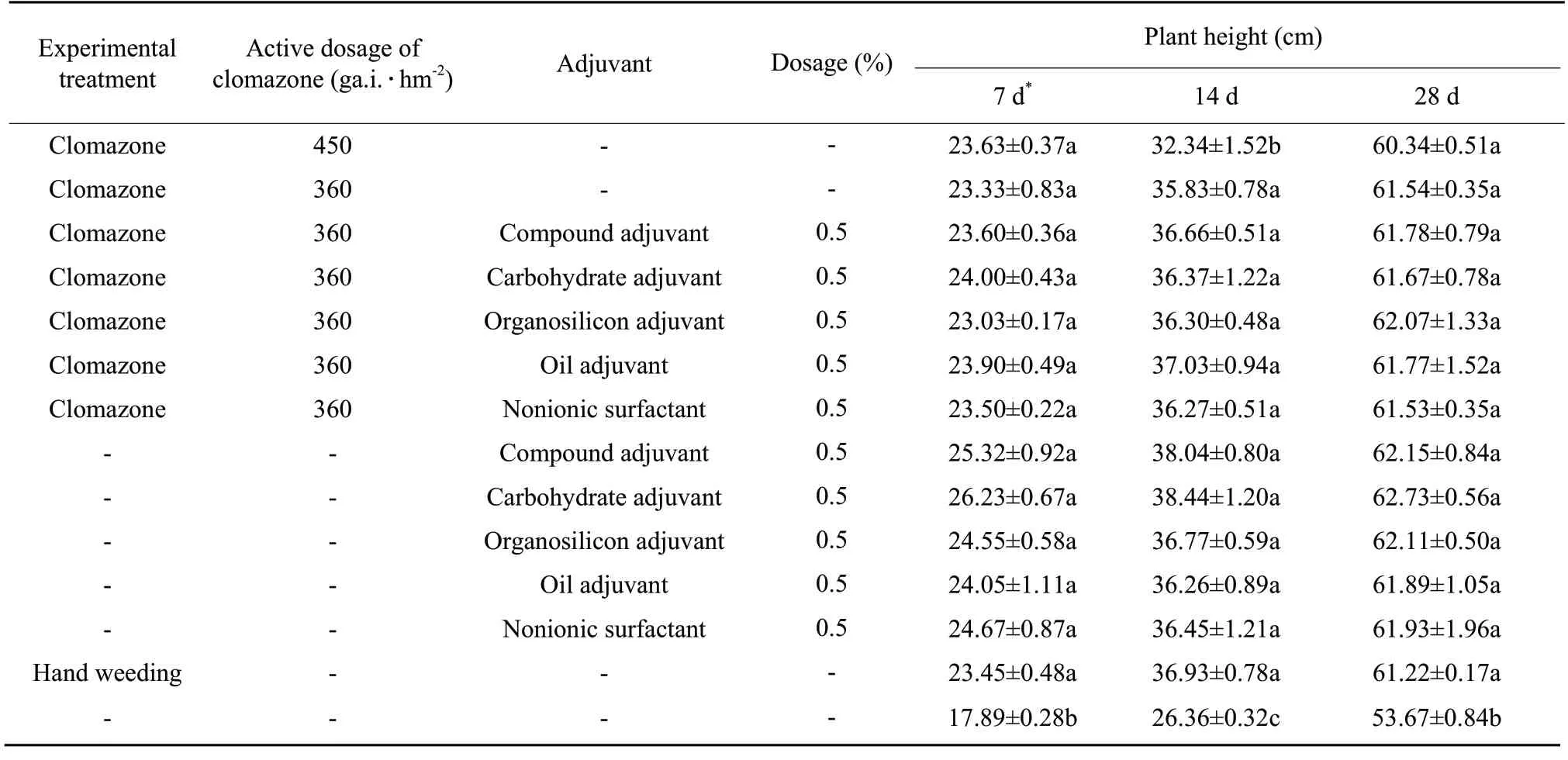
Table 3 Effects of adding different adjuvants to clomazone on soybean height
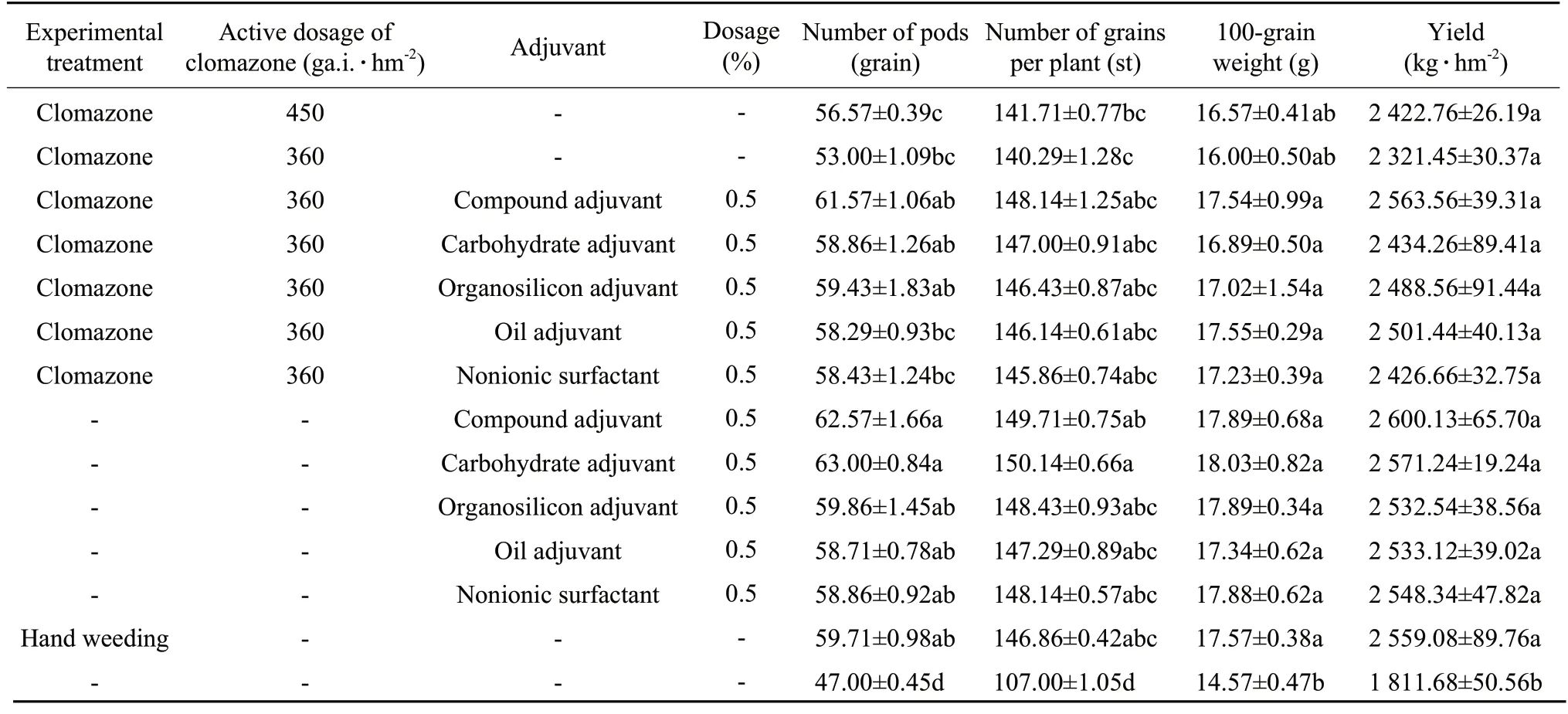
Table 4 Effects of adding different adjuvants to clomazone on soybean production
Discussion
Chemical herbicide control was an effective means for weed management in agricultural production.The herbicide activity could be fully exerted,where it often depended on the adhesion,distribution,wetting,penetration and conduction of droplets on the surface of weed leaves,and all these properties depended on the herbicide formulation and the use of adjuvants(Su and Geng,2002).The physical properties of the adjuvant surface tension,extended diameter,contact angle and drying time played a decisive role in the practical application of adjuvants (Hanet al.,2012;Leiet al.,2021).Adjuvants could reduce the contact angle of herbicides and their surface tension,thus reducing the dose of herbicide applied (Zhang and Zhang,2011;Liuet al.,2013;Liet al.,2019).Yaoet al.(2021) showed that the smaller the surface tension of droplets within a certain size range,the easier it was for the droplets adhering to the surface of the leaves,and the extension diameter of herbicide droplets could directly indicate the extension force of herbicides,and the short drying time helped to reduce the liquid loss.The synergistic effect of the compound adjuvant was the strongest.The compound adjuvant had many components,which could improve the physical properties of the solution concurrently,compensate for the deficiency caused by the herbicide emulsion type,accelerate the drying time,promote the absorption of herbicides by leaves,and improve the efficacy.Oil adjuvants were inferior to nonionic adjuvant and organosilicon adjuvant in increasing the extension diameter,but the final prevention and control ability was significantly greater than those for the two additives;oil additives possessed an affinity for the plant wax layer,which could promote the absorption and penetration of the solution,thus forming a liquid film on the weed surface to reduce the loss of volatilization and drift.The synergistic mechanism and dosage of adjuvants,biological characteristics of weeds,climatic conditions,soil type and other factors affected the effectiveness of herbicides,and the field application environment was more complex.Therefore,the synergistic effects and mechanisms of different types of additives on different dosage forms of herbicides under different environmental conditions required further studies.
With the development of modern agriculture,the effectiveness of herbicide additives had frequently been studied,but the safety of herbicides and their effects on humans,animals and the environment had rarely been reported.The product quality and application effectiveness of auxiliaries played an important role in promoting herbicide reduction and the green development of agriculture.The adjuvants themselves had no herbicidal activity,but some of them had toxic effects on organisms and the environment.Fuet al.(2021) showed that the safety of Silwet 806 was reduced in wheat when mixed with iprodione,with a fresh weight inhibition of 8.18%.The extent of plant damage could be reflected by the aboveground growth and yield of the plants.The results showed that the five adjuvants had no significant effect on the growth and yield of soybean and were safe.Clomazone mixed with oil adjuvants and compound adjuvant were able to increase the soybean yield.Therefore,herbicide adjuvant use could improve the efficacy of herbicides,reduce the amount of clomazone,help reduce the amount of residue in the soil,and reduce the occurrence of crop damage.
Conclusions
The results suggested that the adjuvant effectively increased herbicide control and the differences were observed among the adjuvants.Mixing adjuvants with clomazone could improve the physical properties of the herbicide solution and generally enhance the weed control.The compound adjuvant was the best adjuvants to improve herbicide weed control,which could significantly improve the weed control.The herbicide physical properties were optimized by the adjuvants for increasing the absorption.Adjuvants had no effects on the plant height and yield of soybean.Adjuvants had a high safety in the soybean field.The results provided a theoretical basis for the selection of adjuvants and ideas for the development of adjuvants.Adjuvant use could effectively protect the ecological environment,maintain the normal rotation structure and the ecological balance,and ensure the sustainable development of agriculture and the agricultural economy.
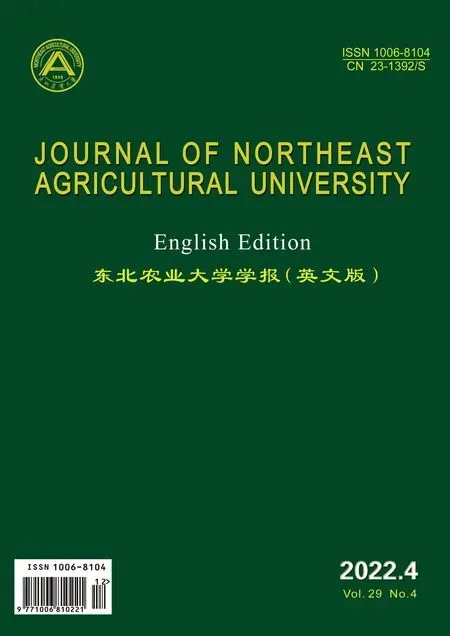 Journal of Northeast Agricultural University(English Edition)2022年4期
Journal of Northeast Agricultural University(English Edition)2022年4期
- Journal of Northeast Agricultural University(English Edition)的其它文章
- Journal of Northeast Agricultural University (English Edition)Instruction to Authors
- Total Contents of Volume 29(2022)
- Research Progress of Vitamins on Muscle Regeneration
- Real-time Prediction Model of Amount of Manure in Winter Pig Pen Based on Backpropagation Neural Network
- Investigation and Analysis of Grassland Plant Germplasm in Zhalantun City of Eastern Inner Mongolia
- Regulation of Migration,Phagocytosis and Apoptosis of Human Neutrophils by Recombinant Human Intestinal Alkaline Phosphatase
